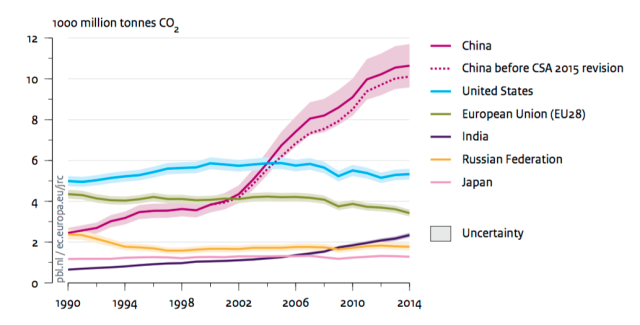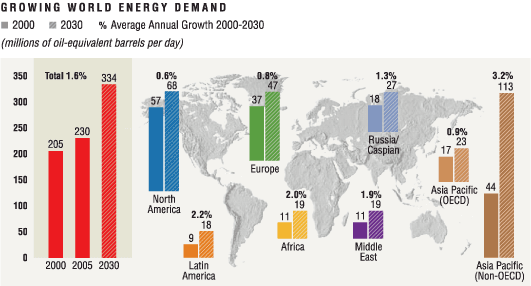Introduction
Environmental conditions have profound effects on the well-being of the humankind. However, despite the recognition of their importance, they remain unaddressed by many business entities. Such an approach is considered undesirable both for the corporate and individual stakeholders in the long run. The following case study explores the effect of negligence towards water stewardship and provides recommendations on the roles of stakeholders in the process.
Conflict of Goals
In order to discuss the responsibilities of the stakeholders in the environmental issues of global warming, it is first necessary to identify the area where the goals of economic growth conflict with the concept of sustainable development. As can be seen from the case, the focal point is the rapid growth of economies in several developing countries. This assertion is corroborated by numerous reports by the environmental organizations and opinions of experts in the field, who point to links between the economic activities of specific countries and observed environmental effects. According to the consensus, China is one of the largest contributors to global carbon emissions (see Appendix A).
It is also widely believed that the magnitude of the effect is sufficient to impact public health within the country and, to some extent, indirectly influence the citizens of other countries (Wolch, Byrne, & Newell, 2014). A similar concern has been raised in regard to India – another major player emerging on a global scale. The massive adverse impact on the environment, including the areas of water and air pollution and carbon emissions, has been attributed primarily to the remarkable economic growth of the recent years (Glasson, Therivel, & Chadwick, 2012). The main reason behind the identified connection is the demand for energy.
A functional economic environment requires the presence of numerous systems, including transportation, communication, and banking, among others. Each of these systems requires significant amounts of energy for effective functioning. In addition, there is an ongoing trend towards the rapid increase in energy demands throughout the economy (see Appendix B). Currently, its production relies heavily on traditional methods, with fossil fuels being the main source of energy.
This method is considered among the primary contributors to the global warming due to massive carbon emissions resulting from it. While cleaner alternative sources of energy exist and are becoming increasingly accessible, many stakeholders still consider them prohibitively expensive and inefficient, especially in the short term. As can be seen, the conflict between the goals of economic growth and the concept of sustainable development stems primarily from the energy requirements and the reluctance to face additional costs associated with the introduction of sustainable energy sources.
Developing Countries Perspective
The described issues are particularly relevant for developing counties. Several causes can be identified as contributing to the issue. First, as was explained in the case study, developing countries experience more challenges in addressing the environmental needs due to the lack of required resources. According to the Kuznets Curve concept, the compliance with environmental regulations requires a significant amount of investment that is likely unavailable to the developing economies (Hamilton & Webster, 2015). While the effect weakens over the course of time, the early stage of development becomes the most challenging. Second, environmental change introduces numerous social and political challenges, each of which is sufficient to create an adverse impact on the country’s population.
For instance, poor environmental conditions inevitably lead to adverse health effects that can be effectively addressed only through a well-developed healthcare system. Since such systems are relatively uncommon for the developing countries, it is evident that the population is expected to suffer from a decline in public health (Watts et al., 2015). In a similar manner, the country’s agricultural segment is easily affected by the climatic changes, which in the case of developing countries has a direct impact on the well-being, and, in extreme cases, survival of the population (Laurance, Sayer, & Cassman, 2014).
Finally, the majority of the effects of environmental issues create financial challenges both at the corporate and the individual level by introducing additional expenses, which makes the populations with lower income especially vulnerable to the issue. As the developing countries are commonly associated with higher levels of poverty, it would be logical to conclude that the effect will be especially prominent.
Water Security Risks
The adverse effects of environmental factors discussed above can be exemplified by the water security concerns. Two main areas of concern can be identified. The first is the use of water for agricultural purposes by the businesses directly involved in the industry. In addition to the effects on the food supplies mentioned in the previous section, this factor impacts the profitability of the companies involved in food production.
Due to the fact that economies of some countries rely heavily on the agricultural sector, it is easy to see how the state of water resources can affect the GDP of the entire country. In addition, the effect can extend beyond the source country and influence the well-being of other stakeholders. As was mentioned in the case, the drought of 2010 in Russia had a profound effect on the prices of food across North Africa and the Middle East, both of which depended on the export of Russian wheat (Hamilton & Webster, 2015). While the effect on agricultural sector is relatively straightforward, its indirect outcomes, such as the political and social unrest resulting from the price changes, are less evident and cannot be reliably predicted.
The second area is the effects on local communities as a result of the industrial use of water. Unlike the agricultural sector, which uses the water mainly for irrigation, various industries utilize it for a variety of purposes, such as a coolant or a component in chemical processes. Water is also an efficient and cheap solvent, which makes it an attractive option in the manufacturing of various goods. Predictably, such treatment often leads to adverse effects such as industrial pollution. In the extreme cases, a significant amount of water resources are rendered unsuitable for consumption and sanitary purposes (WHO, 2013).
The issue is further aggravated by the fact that appropriate water treatment requires significant investment in equipment and staff training, which discourages the companies from responsible environmental practices (McElroy & Van Engelen, 2012). In addition, the adverse impacts eventually become apparent to the local population, which leads to the deteriorating reputation of the business responsible for the effect (Clarke, 2017). In some instances, this prompts companies to conceal their involvement and introduce other unfair practices. It should be emphasized that the described barriers to sustainable practices are widely believed to be short-term (IPCC, 2015). Nevertheless, the lack of strategic planning and an absence of corporate social responsibility practices often limit the corporate vision on the matter.
Stakeholder Responsibilities
The encompassing effect of water quality necessitates a response in the form of responsible practices. However, it should be understood that there is no agreement regarding the distribution of responsibilities on water stewardship. The main reason is the fact that water cannot be owed by any given entity in a sense familiar to businesses and is instead viewed as a common good (Roa, 2013). By extension, it is often assumed that while they have the right to use it on par with others, businesses have no responsibilities regarding the state of water resources. On the other hand, local population, which often suffers the most from the detrimental effects of improper business practices, lacks resources and time necessary to make an impact.
Finally, it should be acknowledged that the issue of uniform access and adequate quality of water is complex and encompassing enough to render piecemeal attempts ineffective. In other words, it requires a coordinated effort of several major stakeholders in order to achieve a noticeable result. From this perspective, for-profit companies should incorporate reasonable corporate social responsibility policies that would allow maintaining healthy business practices that do not compromise water resources in the region.
If designed and implemented properly, in the long term such practices are expected to yield numerous benefits for the business, including a consistent supply of labor force, availability of a crucial resource in the long run, and appositive image. The community should participate by forming activist groups that would raise awareness on the issue and gain sufficient traction to negotiate with influential organizations and businesses. In this way, they can communicate their interests and needs more effectively and achieve the desired result.
Conclusion
Water accessibility and quality are complex issues that require a comprehensive response. Despite the perceived barriers in the form of additional expenses, an appropriately planned response is expected to provide numerous long-term benefits both to the businesses and the local population. Thus, it is reasonable to recommend a collaboration between these stakeholders in order to achieve a favorable result without disrupting the performance and profitability of the organizations.
References
Clarke, T. (2017). International corporate governance: A comparative approach (2nd ed.). New York, NY: Routledge.
Glasson, J., Therivel, R., & Chadwick, A. (2012). Introduction to environmental impact assessment (4th ed.). New York, NY: Routledge.
Hamilton, L., & Webster, P. (2015) The international business environment (3rd ed.). Oxford, England: Oxford University Press.
IPCC. (2015). Fifth assessment report (AR5). Web.
Laurance, W. F., Sayer, J., & Cassman, K. G. (2014). Agricultural expansion and its impacts on tropical nature. Trends in Ecology & Evolution, 29(2), 107-116.
McElroy, M. W., & Van Engelen, J. M. (2012). Corporate sustainability management: The art and science of managing non-financial performance. New York, NY: Routledge.
Roa, D. V. (2013). No water, no business: The importance of water stewardship. Web.
Watts, N., Adger, W. N., Agnolucci, P., Blackstock, J., Byass, P., Cai, W.,… Cox, P. M. (2015). Health and climate change: Policy responses to protect public health. The Lancet, 386(10006), 1861-1914.
WHO. (2013). Sanitation and drinking water. Web.
Wolch, J. R., Byrne, J., & Newell, J. P. (2014). Urban green space, public health, and environmental justice: The challenge of making cities ‘just green enough’. Landscape and Urban Planning, 125, 234-244.
Appendix A
Emission Trends

Appendix B
Growing World Energy Demand
